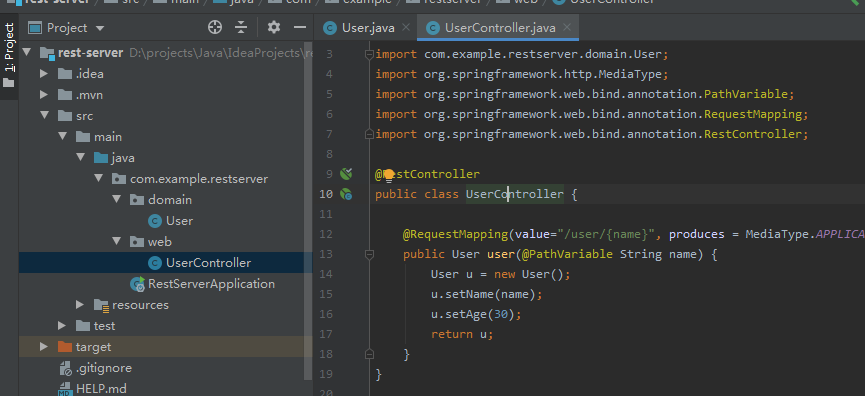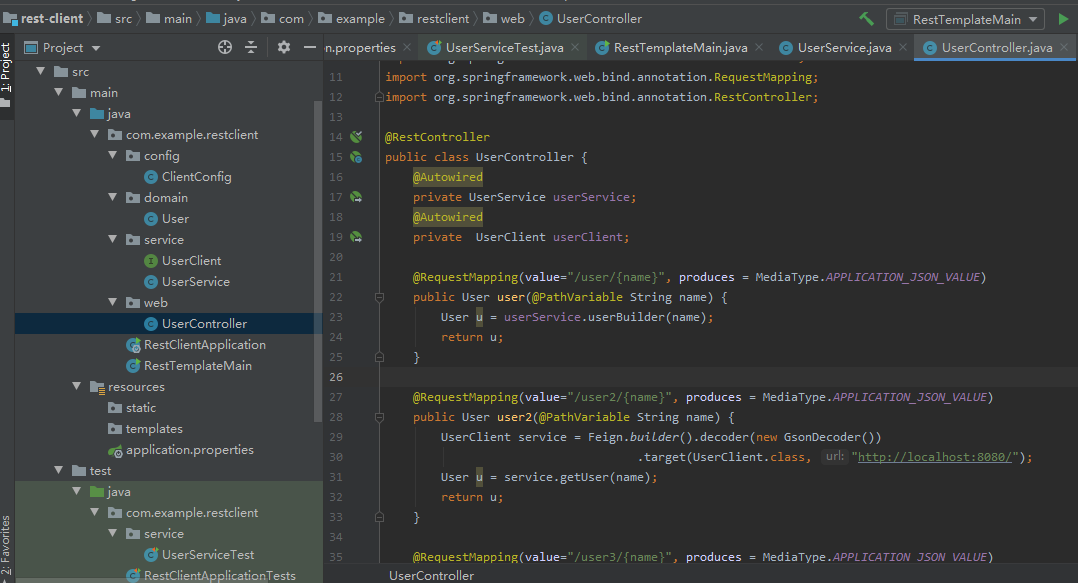开发环境:IntelliJ IDEA 2019.2.2
Spring Boot版本:2.1.8
一、发布REST服务
1、IDEA新建一个名称为rest-server的Spring Boot项目
2、新建一个实体类User.java
package com.example.restserver.domain; public class User { String name; Integer age; public String getName() { return name; } public void setName(String name) { this.name = name; } public Integer getAge() { return age; } public void setAge(Integer age) { this.age = age; } }
3、新建一个控制器类 UserController.java
package com.example.restserver.web; import com.example.restserver.domain.User; import org.springframework.http.MediaType; import org.springframework.web.bind.annotation.PathVariable; import org.springframework.web.bind.annotation.RequestMapping; import org.springframework.web.bind.annotation.RestController; @RestController public class UserController { @RequestMapping(value="/user/{name}", produces = MediaType.APPLICATION_JSON_VALUE) public User user(@PathVariable String name) { User u = new User(); u.setName(name); u.setAge(30); return u; } }
项目结构如下:

访问 http://localhost:8080/user/lc,页面显示:
{"name":"lc","age":30}
二、使用RestTemplae调用服务
1、IDEA新建一个名称为rest-client的Spring Boot项目
2、新建一个含有main方法的普通类 RestTemplateMain.java,调用服务
package com.example.restclient; import com.example.restclient.domain.User; import org.springframework.web.client.RestTemplate; public class RestTemplateMain { public static void main(String[] args){ RestTemplate tpl = new RestTemplate(); User u = tpl.getForObject("http://localhost:8080/user/lc", User.class); System.out.println(u.getName() + "," + u.getAge()); } }
右键Run 'RestTemplateMain.main()',控制台输出:lc,30
3、在bean里面使用RestTemplate,可使用RestTemplateBuilder,新建类 UserService.java
package com.example.restclient.service; import com.example.restclient.domain.User; import org.springframework.beans.factory.annotation.Autowired; import org.springframework.boot.web.client.RestTemplateBuilder; import org.springframework.context.annotation.Bean; import org.springframework.stereotype.Service; import org.springframework.web.client.RestTemplate; @Service public class UserService { @Autowired private RestTemplateBuilder builder; @Bean public RestTemplate restTemplate(){ return builder.rootUri("http://localhost:8080").build(); } public User userBuilder(String name){ User u = restTemplate().getForObject("/user/" + name, User.class); return u; } }
4、编写一个单元测试类,来测试上面的UserService的bean。
package com.example.restclient.service; import com.example.restclient.domain.User; import org.junit.Assert; import org.junit.Test; import org.junit.runner.RunWith; import org.springframework.beans.factory.annotation.Autowired; import org.springframework.boot.test.context.SpringBootTest; import org.springframework.test.context.junit4.SpringRunner; @RunWith(SpringRunner.class) @SpringBootTest(webEnvironment = SpringBootTest.WebEnvironment.NONE) public class UserServiceTest { @Autowired private UserService userService; @Test public void testUser(){ User u = userService.userBuilder("lc"); Assert.assertEquals("lc", u.getName()); } }
5、控制器类UserController.cs 中调用
配置在application.properties 配置端口和8080不一样,如 server.port = 9001
@Autowired private UserService userService; @RequestMapping(value="/user/{name}", produces = MediaType.APPLICATION_JSON_VALUE) public User user(@PathVariable String name) { User u = userService.userBuilder(name); return u; }
三、使用Feign调用服务
继续在rest-client项目基础上修改代码。
1、pom.xml添加依赖
<dependency> <groupId>io.github.openfeign</groupId> <artifactId>feign-core</artifactId> <version>9.5.0</version> </dependency> <dependency> <groupId>io.github.openfeign</groupId> <artifactId>feign-gson</artifactId> <version>9.5.0</version> </dependency>
2、新建接口 UserClient.java
package com.example.restclient.service; import com.example.restclient.domain.User; import feign.Param; import feign.RequestLine; public interface UserClient { @RequestLine("GET /user/{name}") User getUser(@Param("name")String name); }
3、在控制器类 UserController.java 中调用
decoder(new GsonDecoder()) 表示添加了解码器的配置,GsonDecoder会将返回的JSON字符串转换为接口方法返回的对象。
相反的,encoder(new GsonEncoder())则是编码器,将对象转换为JSON字符串。
@RequestMapping(value="/user2/{name}", produces = MediaType.APPLICATION_JSON_VALUE)
public User user2(@PathVariable String name) {
UserClient service = Feign.builder().decoder(new GsonDecoder())
.target(UserClient.class, "http://localhost:8080/");
User u = service.getUser(name);
return u;
}
4、优化第3步代码,并把请求地址放到配置文件中。
(1)application.properties 添加配置
application.client.url = http://localhost:8080
(2)新建配置类ClientConfig.java
package com.example.restclient.config; import com.example.restclient.service.UserClient; import feign.Feign; import feign.gson.GsonDecoder; import org.springframework.beans.factory.annotation.Value; import org.springframework.context.annotation.Bean; import org.springframework.context.annotation.Configuration; @Configuration public class ClientConfig { @Value("${application.client.url}") private String clientUrl; @Bean UserClient userClient(){ UserClient client = Feign.builder() .decoder(new GsonDecoder()) .target(UserClient.class, clientUrl); return client; } }
(3)控制器 UserController.java 中调用
@Autowired private UserClient userClient; @RequestMapping(value="/user3/{name}", produces = MediaType.APPLICATION_JSON_VALUE) public User user3(@PathVariable String name) { User u = userClient.getUser(name); return u; }
UserController.java最终内容:
package com.example.restclient.web; import com.example.restclient.domain.User; import com.example.restclient.service.UserClient; import com.example.restclient.service.UserService; import feign.Feign; import feign.gson.GsonDecoder; import org.springframework.beans.factory.annotation.Autowired; import org.springframework.http.MediaType; import org.springframework.web.bind.annotation.PathVariable; import org.springframework.web.bind.annotation.RequestMapping; import org.springframework.web.bind.annotation.RestController; @RestController public class UserController { @Autowired private UserService userService; @Autowired private UserClient userClient; @RequestMapping(value="/user/{name}", produces = MediaType.APPLICATION_JSON_VALUE) public User user(@PathVariable String name) { User u = userService.userBuilder(name); return u; } @RequestMapping(value="/user2/{name}", produces = MediaType.APPLICATION_JSON_VALUE) public User user2(@PathVariable String name) { UserClient service = Feign.builder().decoder(new GsonDecoder()) .target(UserClient.class, "http://localhost:8080/"); User u = service.getUser(name); return u; } @RequestMapping(value="/user3/{name}", produces = MediaType.APPLICATION_JSON_VALUE) public User user3(@PathVariable String name) { User u = userClient.getUser(name); return u; } }
项目结构

先后访问下面地址,可见到输出正常结果
http://localhost:9001/user/lc
http://localhost:9001/user2/lc2
http://localhost:9001/user3/lc3